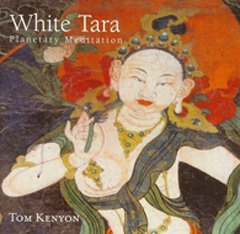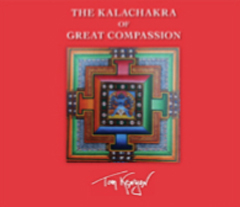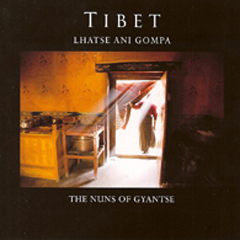A White Tara Sound Meditation
Background
White Tara is known by Tibetan Buddhists as The Swift Protectress because she acts quickly to protect the mind from the snares and delusions of samsara (duality).
As an energy being, she resides in the Sambhogakaya (a Tibetan term meaning the pure realm of light and sound).
In this realm of being she has twenty-one aspects, each one emanating a different color and quality of consciousness.
By her nature, White Tara is luminous white light and sattvic in nature, meaning that her presence is calming, gently transformative and nurturing.
When you focus your attention upon the mantra of White Tara, you immerse yourself in her healing and transformational nature.
According to Tibetan Buddhist tradition, mantras are energetic residing places for those deities to which their mantras correspond. Thus when one contemplates or meditates on the mantra of White Tara, one is transported into the luminous nature of this Bodhisattva of Compassion and into her light-filled realm in the Sambhogakaya.
The Mantras
There are two primary mantras in this sound meditation. The first, and repeated the most, is Tara’s mantra, OM TARE TUTARE TURE SO HA, which roughly translates as “Hail to Tara, the Swift Protectress. May all beings be happy. May all beings be free.”
The second mantra is that of Chenrezig, the Buddha of Infinite Compassion (Avalokiteshvara, in Sanskrit). This mantra is roughly translated as “Hail to the Jewel in the Lotus.” Here, the Jewel refers to compassion and the Lotus to the heart.
Instructions
There are several ways you can focus your attention when listening to this sound meditation. I suggest you experiment with those listed below to discover which ones work best for you. And as always, feel free to experiment.
The Sahasrara (the Crown)
Place your focus of attention at the top of your head (the crown), which is described by yogis and yoginis as the thousand-petalled-lotus (or Sahasrara, in Sanskrit). This transpersonal energy-vortex (chakra) connects you to the vast interdimensional realities of your being. Focusing your attention on this chakra while listening to the sound meditation opens you to the expanded realms of light where White Tara resides.
The Ajna
Place your mental focus at your third eye, located between your physical eyes at the bridge of your nose. This chakra, called the ajna in Sanskrit, is associated with psychic seeing (thus the term, third eye). Focusing your attention here, while listening to the meditation, may stimulate the siddhi (yogic power) sometimes called the perception of inner light.
The Heart
Place your awareness in your heart chakra, an energy-vortex located in the center of your chest beneath the sternum. The heart chakra is a vast universe onto itself, and by focusing your attention here during this sound meditation, you open yourself to the emotionally purifying and healing emanations of White Tara.
Visualization
©1999 Tom Kenyon/Judi Sion
All Rights Reserved
In classic Tibetan Buddhist meditations, meditation deities are often visualized in detail and then focused upon in the mind’s-eye, as if one is physically in the presence of the being. Not all persons possess the visualization abilities required to meditate in this manner, which is why I listed it last. I have included a photo of a traditional Tibetan Buddhist thangka painting depicting White Tara for those who wish to experiment with this type of meditation.
In this form of visualization meditation, it generally helps to have part of your mental focus (i.e. your attention) centered in your ajna (third eye). Imagine that in front of you, the luminous form of White Tara manifests (comes into being) out of darkness (which symbolizes Emptiness, the space out of which all things emerge and return). It is important to understand that you are bringing forward/creating a mental image of Tara whose origin is Emptiness. Visualize her in as much detail as possible as you listen to the sound meditation. Imagine that she can send emanations of light to you as the sound meditation continues. Receive these gifts of luminosity and allow them to enter you. They have an intelligence and wisdom all their own.
When you are complete with the meditation, imagine that Tara is dissolving back into the Emptiness. This is an important phase in this particular form of visualization meditation so that you avoid attachment. Through the act of creating and un-creating the mental image of Tara, you recognize her essential nature as Emptiness (which according to Buddhist Tantra, is the same as yours).
Click to listen:
[audio:White-Tara-Sound-Gift.mp3]Other Related Recordings:
White Tara Planetary Empowerment

This is a live recording of a White Tara Tantric Ceremony that was conducted by Tom during an Intensive in 2010.
The CD begins with a talk by Tom about White Tara and the art of Tantric meditation.
This is then followed by a guided sound meditation that releases the luminosity of White Tara into one’s inner world and as a form of service to Earth and all sentient beings.
A portion of the profits from the sale of this CD goes to humanitarian efforts on behalf of Tibetan monks and nuns.
The Kalachakra of Great Compassion

is a tantric Buddhist meditation centered around the internal union (kalachakra) of White Tara and Chenrezig, or Avaloketashvara, The Buddha of Infinite Compassion.
This unique sound meditation is a potent journey into the luminosity of consciousness. The CD includes a talk by Tom and the complete sound meditation.
A portion of profits from the sale of this CD goes to humanitarian efforts in Tibet.
Tibet Lhatse Ani Gompa

This two-CD set is a rare live recording of Tibetan nuns chanting in their own nunnery in Tibet.
A project of the Sound Healing Foundation, these recordings represent the Foundation’s mission to record, archive and protect sound healing traditions around the world.
The CD set contains the other-worldly and mesmerizing chants of the Gyantse nunnery as they chant to White Tara and to Guru Rinpoche (Padmasambhava).
All profits from the sale of these CDs are returned to the nunnery.




